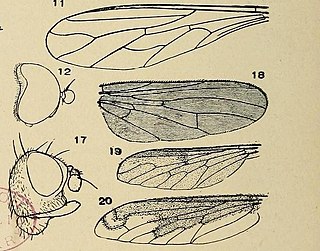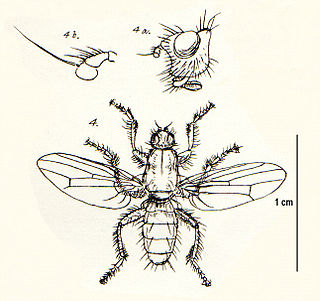
Fucus is a genus of brown algae found in the intertidal zones of rocky seashores almost throughout the world.

Cluster flies are flies of the genus Pollenia in the family Polleniidae. Unlike the more familiar blow flies, such as the bluebottle genus Phormia they do not lay eggs in human food. They parasitise earthworms; the females lay their eggs near earthworm burrows, and the larvae then feed on the worms. But the biology of this group is relatively poorly known and a few have been recorded from other hosts including caterpillars and bees.

The Anthomyiidae are a large and diverse family of Muscoidea flies. Most look rather like small houseflies. Most species are drab grey to black. Many Pegomya are yellow, and some members of the genera Anthomyia and Eutrichota are patterned in black-and-white or black-and-silvery-grey. Most are difficult to identify, apart from a few groups such as the kelp flies that are conspicuous on beaches.

The Coelopidae or kelp flies are a family of Acalyptratae flies, they are sometimes also called seaweed flies, although both terms are used for a number of seashore Diptera. Fewer than 40 species occur worldwide. The family is found in temperate areas, with species occurring in the southern Afrotropical, Holarctic, and Australasian regions.

The Helcomyzidae are a small family of flies in the Acalyptratae. The larvae feed on kelp and other organic matter washed up on shorelines. Species diversity is highest in New Zealand and south temperate South America. They are sometimes allied with the families Dryomyzidae or Coelopidae.

Coelopa frigida is a species of seaweed fly or kelp fly. It is the most widely distributed species of seaweed fly. It can be found on most shorelines in the temperate Northern Hemisphere. Other species of seaweed flies include Coelopa nebularum and Coelopa pilipes. C. frigida feeds primarily on seaweed, and groups of C. frigida flies tend to populate near bodies of water. Climate change has led to an increase in C. frigida blooms along shores, which creates a pest problem for human beach-goers. C. frigida is also an important organism for the study of sexual selection, particularly female choice, which is influenced by genetics.

Heterocheila is a genus of acalyptrate true flies (Diptera). They are placed in their own family, Heterocheilidae, in the superfamily Sciomyzoidea. They are not widely familiar outside entomological circles, but the common name "half-bridge flies" has been associated with them. They are medium-sized flies occurring mainly in temperate regions on seashores of the Northern Hemisphere, where they and their larvae typically feed on stranded kelp in the wrack zone. In this, they resemble kelp flies, which are members of a different family, though the same superfamily.

Kelp fly is one common name of species of flies in a number of families of "true flies" or Diptera. They generally feed on stranded and rotting seaweed, particularly kelp in the wrack zone. When conditions are suitable they are very numerous and may be ecologically important in the turnover of organic material on the coast. In this role they also may be an important item in the diet of beach-dwelling animals and birds. The flies most generally referred to as kelp flies are the widely distributed Coelopidae, such as Coelopa pilipes. In popular speech however, they are not clearly distinguished from other flies with similar feeding habits, such as the Heterocheilidae, the Helcomyzinae and sundry members of the Anthomyiidae.

Empidinae, also called dance flies, are a subfamily of empidoid flies. They are mainly predatory flies like most of their relatives, and generally small to medium-sized. Most species are flower visitors and they can be effective pollinators.

This is a genus of kelp fly in the family Coelopidae. As of 2017, it is monotypic, consisting of its type species This canus. This and T. canus were respectively circumscribed and described in 1991 by the Australian entomologist David K. McAlpine. It is endemic to southern Australia.
Coelopa vanduzeei is a species of kelp flies in the family Coelopidae.

Coelopa is a genus of kelp flies in the family Coelopidae. There are about 14 described species in Coelopa.

Coelopa pilipes is a common European species of kelp fly. It was described by A. H. Haliday in 1838. Their appearance differs greatly from that of other Coelopa flies.

Chaetocoelopa is a genus of kelp flies in the family Coelopidae.
Beaopterus is a genus of kelp fly in the family Coelopidae.
Coelopella is a genus of kelp flies in the family Coelopidae.
Glumini is a tribe of kelp flies in the family Coelopidae.
Coelopellini is a tribe of kelp flies in the family Coelopidae.
Coelopinae is a subfamily of kelp flies in the family Coelopidae.

Fergusonina, the sole genus in the family of Fergusoninidae, are gall-forming flies. There are about 40 species in the genus, all of them producing galls on Eucalyptus, Melaleuca, Corymbia, and Metrosideros species in Australia and New Zealand.



















